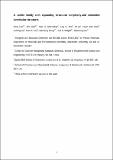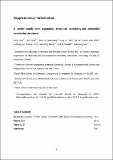Files in this item
A zeolite family with expanding structural complexity and embedded isoreticular structures
Item metadata
| dc.contributor.author | Guo, Peng | |
| dc.contributor.author | Shin, Jiho | |
| dc.contributor.author | Greenaway, Alex | |
| dc.contributor.author | Min, Jung Gi | |
| dc.contributor.author | Su, Jie | |
| dc.contributor.author | Choi, Hyun June | |
| dc.contributor.author | Liu, Leifeng | |
| dc.contributor.author | Cox, Paul | |
| dc.contributor.author | Bong Hong, Suk | |
| dc.contributor.author | Wright, Paul Anthony | |
| dc.contributor.author | Zou, Xiaodong | |
| dc.date.accessioned | 2016-01-15T00:12:13Z | |
| dc.date.available | 2016-01-15T00:12:13Z | |
| dc.date.issued | 2015-08-06 | |
| dc.identifier | 194639998 | |
| dc.identifier | 2059bfb9-6cd1-462e-97b9-29ef13af3dfe | |
| dc.identifier | 84938801884 | |
| dc.identifier | 000359002300034 | |
| dc.identifier.citation | Guo , P , Shin , J , Greenaway , A , Min , J G , Su , J , Choi , H J , Liu , L , Cox , P , Bong Hong , S , Wright , P A & Zou , X 2015 , ' A zeolite family with expanding structural complexity and embedded isoreticular structures ' , Nature , vol. 524 , no. 7563 , pp. 74-78 . https://doi.org/10.1038/nature14575 | en |
| dc.identifier.issn | 0028-0836 | |
| dc.identifier.other | ORCID: /0000-0002-4243-9957/work/62668301 | |
| dc.identifier.uri | https://hdl.handle.net/10023/8020 | |
| dc.description | The authors acknowledge financial support from the Swedish Research Council (VR), the Swedish Governmental Agency for Innovation Systems (VINNOVA), the Röntgen-Ångström Cluster through the project grant MATsynCELL, the Knut and Alice Wallenberg Foundation through the project grant 3DEM-NATUR, the NCRI (2012R1A3A-2048833) and BK 21-plus programmes through the National Research Foundation of Korea, and the UK EPSRC (EP/J02077X/1). | en |
| dc.description.abstract | The prediction and synthesis of new crystal structures enable the targeted preparation of materials with desired properties. Among porous solids, this has been achieved for metal–organic frameworks1, 2, 3, but not for the more widely applicable zeolites4, 5, where new materials are usually discovered using exploratory synthesis. Although millions of hypothetical zeolite structures have been proposed6, 7, not enough is known about their synthesis mechanism to allow any given structure to be prepared. Here we present an approach that combines structure solution with structure prediction, and inspires the targeted synthesis of new super-complex zeolites. We used electron diffraction to identify a family of related structures and to discover the structural ‘coding’ within them. This allowed us to determine the complex, and previously unknown, structure of zeolite ZSM-25 (ref. 8), which has the largest unit-cell volume of all known zeolites (91,554 cubic ångströms) and demonstrates selective CO2 adsorption. By extending our method, we were able to predict other members of a family of increasingly complex, but structurally related, zeolites and to synthesize two more-complex zeolites in the family, PST-20 and PST-25, with much larger cell volumes (166,988 and 275,178 cubic ångströms, respectively) and similar selective adsorption properties. Members of this family have the same symmetry, but an expanding unit cell, and are related by hitherto unrecognized structural principles; we call these family members embedded isoreticular zeolite structures. | |
| dc.format.extent | 1304362 | |
| dc.format.extent | 3352286 | |
| dc.language.iso | eng | |
| dc.relation.ispartof | Nature | en |
| dc.subject | Carbon dioxide | en |
| dc.subject | Metal organic framework | en |
| dc.subject | Zeolite | en |
| dc.subject | Adsorption kinetics | en |
| dc.subject | Article | en |
| dc.subject | Cell volume | en |
| dc.subject | Chemical structure | en |
| dc.subject | Complex formation | en |
| dc.subject | Crystallization | en |
| dc.subject | Electron diffraction | en |
| dc.subject | QD Chemistry | en |
| dc.subject | DAS | en |
| dc.subject | BDC | en |
| dc.subject | R2C | en |
| dc.subject.lcc | QD | en |
| dc.title | A zeolite family with expanding structural complexity and embedded isoreticular structures | en |
| dc.type | Journal article | en |
| dc.contributor.sponsor | EPSRC | en |
| dc.contributor.institution | University of St Andrews. School of Chemistry | en |
| dc.contributor.institution | University of St Andrews. EaSTCHEM | en |
| dc.identifier.doi | 10.1038/nature14575 | |
| dc.description.status | Peer reviewed | en |
| dc.date.embargoedUntil | 2016-01-15 | |
| dc.identifier.url | https://www.nature.com/articles/nature14575#Sec11 | en |
| dc.identifier.grantnumber | EP/J02077X/1 | en |
This item appears in the following Collection(s)
Items in the St Andrews Research Repository are protected by copyright, with all rights reserved, unless otherwise indicated.


